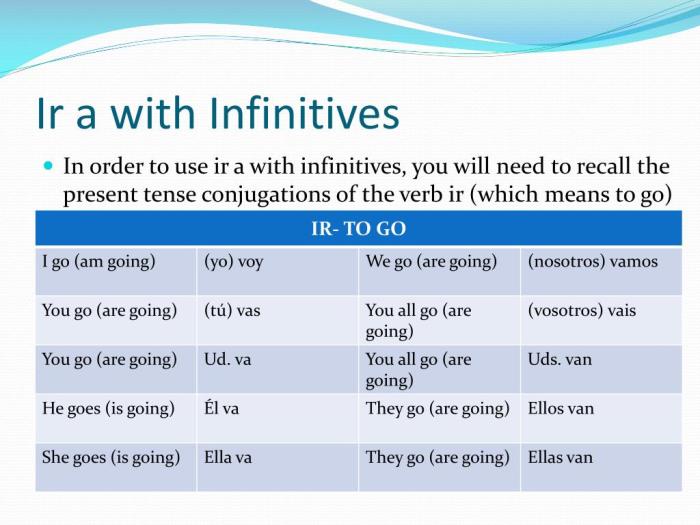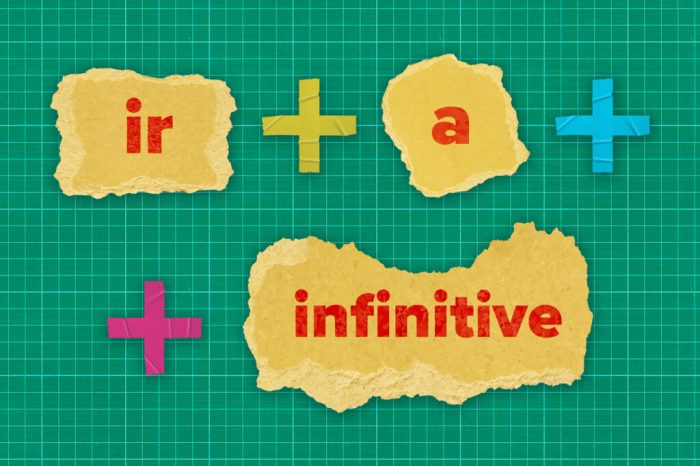Embark on an engaging journey with ir a + infinitive practice, the ultimate guide to expressing future intentions, predictions, and imminent actions in Spanish. This comprehensive guide will equip you with the knowledge and skills to master this versatile construction and elevate your Spanish proficiency.
Delve into the intricacies of ir a + infinitive, its conjugation, and its nuanced usage. Discover how to express your future plans, make predictions with confidence, and describe actions that are about to unfold.
Overview of “Ir a + Infinitive” Usage

The “ir a + infinitive” construction in Spanish serves a specific purpose and function in conveying actions or intentions that are planned or expected to happen in the near future.
This construction is commonly employed in various contexts, such as expressing intentions, plans, predictions, or even scheduled events. By utilizing “ir a,” the speaker indicates that the action described by the infinitive is imminent or highly likely to occur.
Example Usage
- Intentions: “Voy a estudiar para el examen.”(I’m going to study for the exam.)
- Plans: “Vamos a viajar a España el próximo verano.”(We’re going to travel to Spain next summer.)
- Predictions: “Creo que va a llover mañana.”(I think it’s going to rain tomorrow.)
- Scheduled Events: “El avión va a aterrizar en una hora.”(The plane is going to land in an hour.)
Conjugation and Formation: Ir A + Infinitive Practice
Conjugating “ir” is essential for constructing the “ir a + infinitive” phrase. Let’s explore the rules and steps involved.
Present Tense Conjugation
In the present tense, “ir” is conjugated as follows:
| Person | Conjugated Form |
|---|---|
| Yo | voy |
| Tú | vas |
| Él/Ella/Usted | va |
| Nosotros | vamos |
| Vosotros | vais |
| Ellos/Ellas/Ustedes | van |
Future Tense Conjugation
To conjugate “ir” in the future tense, use the following forms:
| Person | Conjugated Form |
|---|---|
| Yo | iré |
| Tú | irás |
| Él/Ella/Usted | irá |
| Nosotros | iremos |
| Vosotros | iréis |
| Ellos/Ellas/Ustedes | irán |
Conditional Tense Conjugation
In the conditional tense, “ir” is conjugated as follows:
| Person | Conjugated Form |
|---|---|
| Yo | iría |
| Tú | irías |
| Él/Ella/Usted | iría |
| Nosotros | iríamos |
| Vosotros | iríais |
| Ellos/Ellas/Ustedes | irían |
Forming the “Ir a + Infinitive” Construction
To form the “ir a + infinitive” construction, simply conjugate “ir” in the appropriate tense and follow it with the infinitive form of the main verb.
Voy a comer. (I am going to eat.)Vas a estudiar. (You are going to study.) Irá a trabajar. (He/She/You are going to work.)
Expressing Future Intentions
Ir a+ infinitive is a common way to express future intentions or plans in Spanish. It is similar to the English “going to” construction.
Example Sentences, Ir a + infinitive practice
- Voy a estudiarpara el examen. (I am going to study for the exam.)
- Vamos a comeren el restaurante. (We are going to eat at the restaurant.)
- No voy a ira la fiesta. (I am not going to go to the party.)
Difference from Other Future Tense Forms
Ir a+ infinitive is different from other future tense forms in Spanish, such as the simple future ( futuro simple) and the future perfect ( futuro perfecto). The simple future is used to express general predictions or events that are likely to happen, while the future perfect is used to express events that will have happened by a certain time in the future.
Ir a+ infinitive, on the other hand, is used to express specific intentions or plans that the speaker has. It is often used when the speaker is making a decision or commitment to do something.
Expressing Predictions

The “ir a + infinitive” construction can also be used to make predictions or express probabilities. This usage is similar to using “will” or “going to” in English.
Factors Influencing Accuracy
The accuracy of predictions made using “ir a + infinitive” depends on several factors, including:
- The speaker’s knowledge and experience:The more knowledge and experience the speaker has on the topic, the more accurate their predictions are likely to be.
- The availability of relevant information:The more relevant information the speaker has, the more accurate their predictions are likely to be.
- The complexity of the prediction:Simple predictions are more likely to be accurate than complex predictions.
Expressing Imminent Actions
Ir a + infinitive can also be used to describe actions that are about to happen. This usage is similar to the present progressive tense, but it emphasizes the immediacy of the action.
After wrapping up our practice with ir a + infinitive, it’s time to shift gears and prepare for the upcoming AP Gov midterm. To help you ace this crucial exam, check out this comprehensive ap gov midterm study guide . Once you’ve brushed up on your political knowledge, let’s return to our ir a + infinitive practice and master this essential Spanish grammar concept.
For example, the sentence “Voy a comer” means “I am going to eat.” This sentence suggests that the speaker is about to eat, and the action is imminent.
Difference between “Ir a + infinitive” and the present progressive tense
The main difference between “ir a + infinitive” and the present progressive tense is that “ir a + infinitive” emphasizes the immediacy of the action. The present progressive tense, on the other hand, simply indicates that an action is happening now.
For example, the sentence “Estoy comiendo” means “I am eating.” This sentence simply states that the speaker is currently eating, but it does not necessarily imply that the action is about to happen.
Common Mistakes and Exceptions
Using “ir a + infinitive” correctly is crucial to avoid confusion and convey your intended meaning. Here are some common mistakes to watch out for and their correct alternatives:
Using the Present Tense of “Ir”
A common error is using the present tense of “ir” instead of the future tense. Remember that “ir a” is a future tense construction and should be used with the future tense of the infinitive, as in “voy a comer” (I’m going to eat), not “voy comer” (I eat).
Forgetting the “a”
Another common mistake is omitting the “a” between “ir” and the infinitive. The “a” is an essential part of the construction and must be included, as in “vamos a bailar” (we’re going to dance), not “vamos bailar” (we dance).
Exceptions to “Ir a + Infinitive”
While “ir a + infinitive” is generally used to express future intentions, there are a few exceptions where it may have a different meaning:
- Expressing an imminent action:In some cases, “ir a + infinitive” can indicate an action that is about to happen, as in “voy a estornudar” (I’m about to sneeze).
- Expressing an obligation:“Ir a + infinitive” can also be used to express an obligation or necessity, as in “tengo que ir a trabajar” (I have to go to work).
- Expressing a destination:When used with a place or destination, “ir a + infinitive” indicates a direction or goal, as in “voy a ir a la tienda” (I’m going to go to the store).
Questions and Answers
What is the purpose of “ir a + infinitive”?
Ir a + infinitive is a grammatical construction used to express future intentions, predictions, and imminent actions in Spanish.
How do I conjugate “ir” in “ir a + infinitive”?
In the present tense, “ir” is conjugated as “voy” (I go), “vas” (you go), “va” (he/she/it goes), “vamos” (we go), “vais” (you all go), and “van” (they go).
How do I express a future intention using “ir a + infinitive”?
To express a future intention, simply conjugate “ir” in the present tense and follow it with the infinitive of the main verb. For example, “Voy a comer” means “I am going to eat.”